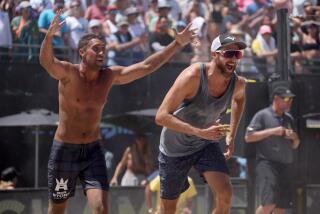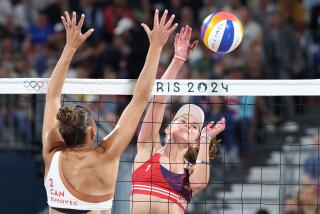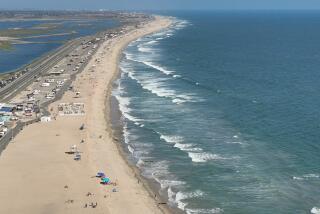Manhattan Tourney, the Wimbledon of Volleyball : â68 Match Called âMost Famousâ of All Time
As the story goes, the early evening chill prompted the anonymous volleyball fan to relinquish his place in the sand, pick up his towel and trudge to his car, despite the fierce battle that was unfolding before him in the finals of the 1968 Manhattan Beach Open.
âThey say he went home, showered, changed into warmer clothes, drove back and found a parking space, and only three points had been scored,â said Larry Rundle, now a 44-year-old mortgage banker.
Rundle and partner Henry Bergman were pitted against beach legends Ron Von Hagen and Ron Lang in three grueling contests so evenly matched that they outlasted the August sun, ending in the dim glow of headlights from nearby parked cars. It was the most storied finish in the 30 years of the Manhattan Beach Open, an event long heralded as the Wimbledon of beach volleyball.
In this yearâs tournament, which will begin Sunday and conclude on the Fourth of July in the sand south of Manhattan Beach pier, history may again be made. Mike Dodd and Tim Hovland, the current money leaders on the menâs pro tour, could become the first individual players--and the first team--to win the open six times.
Von Hagen, Jim Menges, Mike OâHara and Mike Bright have won the tournament five times, and only OâHara and Bright, who took the first five Manhattan Beach Open championships (1960-64), can match Dodd-Hovlandâs record as a team.
But whatever happens in next weekâs $75,000 spectacle, it probably wonât have the impact of that night in 1968, when the prize was a simple trophy and boasting rights on the beach.
And, though the players didnât know it at the time, a permanent place in volleyball lore.
âThat was the most famous beach volleyball match of all-time,â said Chris Marlowe, who won the event in 1976 and 1977. âAnd Manhattan was the biggest. It was always the biggest tournament of the summer.â
Marlowe, now a television commentator for cable broadcasts of the menâs and womenâs pro volleyball tours, has little trouble describing what made the Manhattan Beach Open special.
âThere was just something about that tournament,â he said. âIt always had the most teams and the most fans. It wasnât uncommon for 10,000 to 15,000 people to be there. And, this may sound stupid, but they had the best balls, the courts were situated perfectly. It was Wimbledon. It was the world championship.â
Said Fred Zuelich, a Manhattan Beach realtor who won the open in 1973: âWinning the Manhattan Open was probably the highlight of anybodyâs career. The whole idea of the open was it strived to be that one tournament. The big one. It used to be held in August and youâd play all summer long, jockey for position and see who you wanted to play with in the open.â
For Rundle, the difference was the crowd, which surrounded the court for several yards in every direction--leaving a postage stamp of sand in the midst of a mass of people--and lined the pier to the north and The Strand to the east.
âIn Santa Barbara, in the finals, there was hardly anyone at all, maybe 500 people,â he said. âBut at Manhattan, I remember my dad telling me later: âThey were three-deep all the way around the pier. Three-deep !â â
The Manhattan Beach Open was different from the start. OâHara remembers coming down from his home courts north of Santa Monica for the first open in 1960.
âIt was a happening,â said the 56-year-old sports promoter. âNo one was anticipating the numbers of people. The environment was so good. With the pier there, itâs just so conducive to volleyball. And the people embraced it from the first day.â
From the start, OâHara and Bright became the team to beat, winning the first five opens. The record for consecutive victories stood uncontested until Dodd and Hovland came along in the 1980s and won four straight opens (1982-85).
During the mid-1980s, however, things were changing on the volleyball scene. Sponsors had pumped big prize money into the beach game, the pro tour was expanded to cover the entire country and the players had organized a union. Differences between the newly formed Assn. of Volleyball Professionals and organizers of the Manhattan Beach Open prompted the AVP to sanction two events in 1986 and 1987, dividing its players between Manhattan Beach and another AVP-sanctioned event.
The victims of the arrangement in 1986 were Dodd and Hovland, who lost a coin flip to Sinjin Smith and Randy Stoklos and were forced to play in New Jersey rather than get their shot at tying OâHara and Brightâs record. Smith and Stoklos won at Manhattan.
In 1987, Dodd and Hovland were back and won their fifth open, tying the individual and team records for total victories. But in 1988, the AVPâs rift with Manhattan Beach Open organizers widened and the AVP refused to sanction the event.
Now the pros and the city are back together and Dodd and Hovland are once again within reach of the records, if they can get past Smith and Stoklos (who lead the tour with five tournament victories) and Karch Kiraly and Brent Frohoff (who won the last two events they played together before Kiraly missed three weekends due to commitments with the U.S. National team).
Hovland, who recalls watching the Manhattan Beach Open at age 8, says heâs proud to be in the position of passing the players he watched and idolized: Von Hagen, Menges, Lang.
âIt just shows that weâve been around now a long time, too. They were the best of their time and weâre the best of our time,â said Hovland, who grew up in Westchester, lives in El Segundo and considers the Manhattan Beach Open his home turf, to be protected from the invaders to the north. Itâs also a homecoming for Dodd, a Manhattan Beach native, .
âWe run the South Bay,â Hovland proclaimed. âSinjin and Randy can have Santa Monica.â
As Rundle recalls it, Rundle-Bergman and Von Hagen-Lang had divided the six tournaments between them before their 1968 showdown in the double-elimination Manhattan Beach Open. It began in the early afternoon with the finals of the winnerâs bracket.
Back then, matches in the winnerâs bracket were best-two-games-out-of-three to 11 points, with the winning team required to outscore the loser by at least two points. (Today, teams play a single game to 15.) If a team was ahead 11-10, it needed to score again to win by two. But if the opposition scored first, a minimum score of 13 was needed to win.
And so on . . . and so on.
âItâs my recollection that the scores were 21-19, 19-17, 20-18. Something like that,â Rundle said. âIt lasted about 3 1/2 hours.â
Von Hagen and Lang emerged the winners, forcing Rundle and Bergman to play the winner of the losers bracket for a chance to return to the championship match against Von Hagen-Lang. Rundle-Bergman easily won the single game to 15 and the rematch was on.
âWe started (the championship match) at around 5 or 5:30,â Rundle recalled. âBut this was the dead of summer, so we had a good 3 1/2 hours of sunlight. Then the same darn thing that happened in the winners bracket finals happened again: Nobody could get ahead. It was pass-set-hit, pass-set-hit ad nauseam.â
More than two decades have not quelled Rundleâs enthusiasm when he recalls that night. âThe four of us, with our combination of skills, were just able to keep it going until the sun went down, and thatâs exactly what happened,â he said.
âNobody missed passes, nobody overset and nobody could dig anybody, and the crowd would just explode when somebody finally made a point. People just didnât leave the beach. There was this incredible match going on and they had to find out who was going to win.â
The sun was low when Rundle-Bergman won, forcing a âdouble final.â When the winner of the losers bracket beat the winners bracket champion in the finals, there was a final game to 15 to decide the victor--a rule that stands today. And the four men decided they would play it out that day, no matter what happened.
âWe started that game at about 7:30, and by 8:15, it was something like 5-3,â Rundle said. Owners of cars parked along The Strand tried to illuminate the court with their headlights and lifeguards also tried to shed light on the seemingly never-ending struggle.
But the faint light wasnât enough, particularly for Lang, one of the pioneers of the game who was nearing the end of his career. When the game had deteriorated into a contest of who had the best eyesight, he was the loser. And when Rundle went with his âhigh boyâ--an underhand serve with a towering arc--Lang and Von Hagen were helpless. They simply couldnât see it.
In an anticlimactic ending to a phenomenal match, Rundle and Bergman were the winners.
âIt was amazing to observe,â said Zuelich, who says he was a âkid in the standsâ in 1968, whose open victory five years later occurred on the following Friday due to darkness. âIt was an awesome spectacle, seeing guys hitting the ball 90, 100 m.p.h. in the dark and some guy popping it back up. It was a tremendous physical feat.â
But Rundle said he was reticent to claim victory in 1968. âIâve always considered it a draw,â he said. âIf ever four guys were evenly matched on a given day, that was it.â
Rundle laughed. âIt was, what, 21 years ago? I recovered only last week. I just got my breath back.â
More to Read
Go beyond the scoreboard
Get the latest on L.A.'s teams in the daily Sports Report newsletter.
You may occasionally receive promotional content from the Los Angeles Times.










